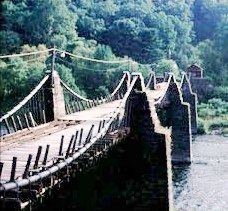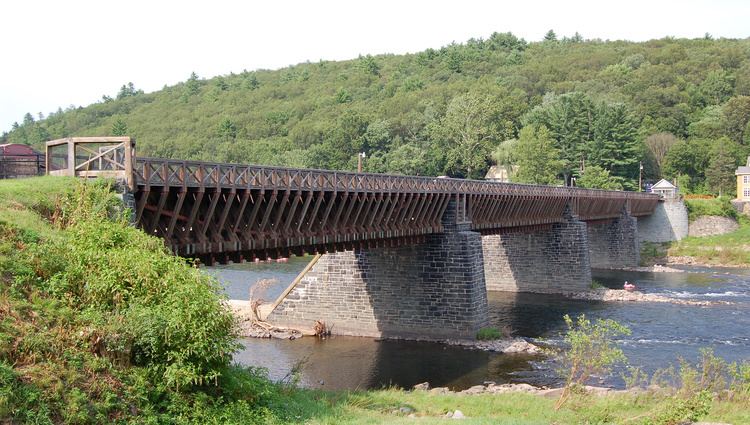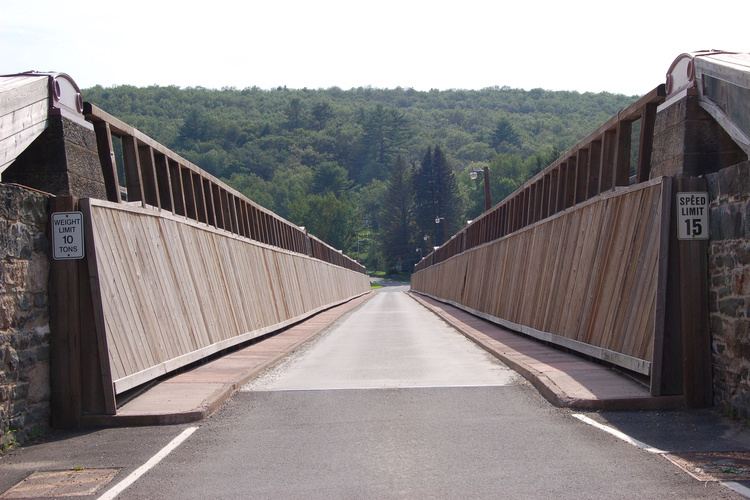Opened 1849 Location Minisink Ford Bridge type Suspension bridge | Other name(s) Roebling Bridge Design Suspension bridge Length 163 m | |
Carries Motor vehicles, pedestrians Similar Zane Grey Museum, Delaware and Hudson, Skinners Falls–Milanville Bridge, Pond Eddy Bridge, Barryville–Shohola Bridge | ||
Roebling's Delaware Aqueduct, also known as the Roebling Bridge, is the oldest existing wire suspension bridge in the United States. It runs 535 feet (175 meters) over the Delaware River, from Minisink Ford, New York, to Lackawaxen, Pennsylvania. Opened in 1849 as an aqueduct connecting two parts of the Delaware & Hudson Canal (D&H), it has since been converted to carry automotive traffic and pedestrians.
Contents

Roebling s delaware aqueduct eastbound
Construction

The bridge was begun in 1847 as one of four suspension aqueducts on the D&H Canal, a system of transportation connecting the coal fields of northeastern Pennsylvania with markets on the Hudson River. The canal opened in 1828, was enlarged after the 1840s, and closed in 1898.

Russell F. Lord and John A. Roebling designed the bridge and supervised its construction. Roebling would design the Brooklyn Bridge 20 years later.

Two important local industries with conflicting needs brought about construction of Roebling's Delaware and Lackawaxen Aqueducts: canal traffic and timber rafting. Since the mid-18th century, timber from the Delaware valley had been floated down the river to shipyards and industries in Trenton and Philadelphia. The D&H Canal's rope ferry crossing of the Delaware at Lackawaxen created a bottleneck, and there were numerous collisions with timber rafts headed downstream. In 1846, to alleviate both problems, the D&H Canal Company approved Russell F. Lord's plan to substitute two new aqueducts in place of the rope ferry.
After evaluating several options, Lord recommended designs submitted by John A. Roebling, who had already built a wire suspension aqueduct at Pittsburgh in 1845. To raise the canal enough to allow the passage of ice floes and river traffic, Lord's plan called for three locks to be built on the eastern side.
An immediate success, the Delaware Aqueduct — which cost $41,750 – and the Lackawaxen Aqueduct — which cost $18,650, and of which only the abutments remain – reduced canal travel time by one full day, saving thousands of dollars annually.
Post-construction history
After the canal closed in 1898, the aqueduct was drained and converted into a vehicular bridge. Eventually, the canal sides and towpaths (walkways for those pulling barges) were removed. It operated as a toll bridge for wagons and, later, motor vehicles until 1979.
Portions of the D&H Canal, including the Delaware Aqueduct, were designated a National Historic Landmark in 1968. The Delaware Aqueduct is also designated a National Civil Engineering Landmark.
The National Park Service bought the bridge in 1980. The agency rebuilt the bridge's superstructure from Roebling's original plans and specification in 1986, and in 1995, the wooden icebreakers, towpaths and aqueduct walls were reconstructed, restoring the bridge's original appearance as an aqueduct. The bridge is now part of the Upper Delaware Scenic and Recreational River.
